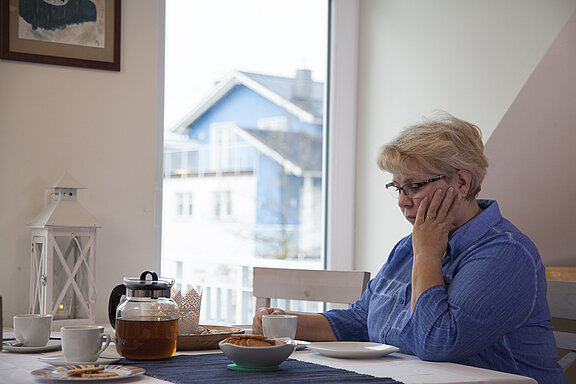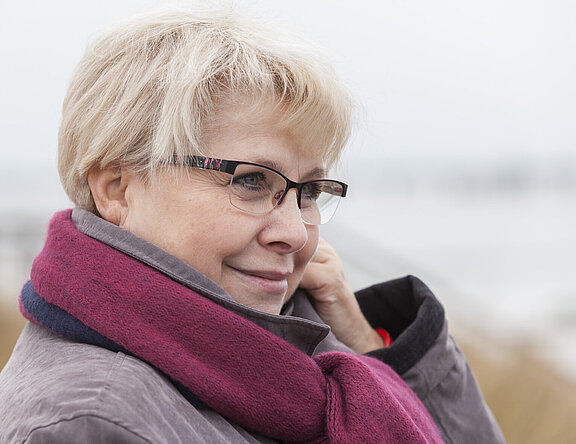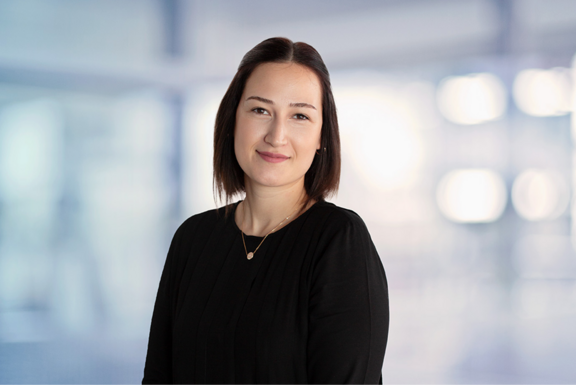Ilona’s testimonial about obstructive sleep apnoea (OSA)
In this patient story, we present Ilona M.’s personal story and give you more information about one of the most common warning signs of sleep apnoea and daytime sleepiness. Especially in connection with breathing pauses at night and loud snoring, the suspicion of obstructive sleep apnoea (OSA) is obvious. But other sleep disorders can also lead to interrupted sleep phases and thus an unhealthy sleep cycle.
Due to severe sleep apnoea, Ilona M. suffers from severe daytime sleepiness and can hardly manage her everyday life. Even daily household chores become increasingly difficult for her and eventually she even falls asleep during the day, for no apparent reason. Despite seemingly enough sleep, she is constantly tired. This is because those affected themselves usually only notice very late on that symptoms such as constant tiredness, headaches and depressive moods can indicate sleep apnoea syndrome. The leading symptoms, such as loud snoring and breathing pauses at night, are often first noticed by relatives. In Ilona M.’s case, it was her granddaughter who gave the decisive clue. Thanks to the innovative Inspire therapy, Mrs M. is now active once more, can master her everyday life again, and enjoy time with her loved ones.
Fatigue was her constant companion

For Ilona M., her family means everything. After a serious car accident, she enjoys her free time as an early retiree with her loved ones and friends, especially her seven-year-old granddaughter. The fact that she has so much energy for her children and grandchildren today is not something she takes for granted.
For many years, despite sufficient sleep, she is always exhausted, tired and feels listless. Due to the sleep disorders, she suffers from daytime sleepiness and even simple activities, such as making the bed, become increasingly difficult for her. Her granddaughter also notices that something is wrong:
‘Grandma, I don't want to sleep at yours any more. I’m afraid you’ll stop breathing again in your sleep.’
Then Ilona M. realises the seriousness of the situation and goes to see a doctor. This is a typical case because most people do not even notice that something is wrong and that they stop breathing at night. It is often family or a partner who are alarmed by the long pauses in breathing followed by gasps for air and loud snoring. Frequent pauses in breathing during sleep are one of the main symptoms of obstructive sleep apnoea, along with daytime sleepiness and snoring. On the other hand, not every loud snore is a sign of obstructive sleep apnoea. As long as breathing is normal, the snoring is probably harmless, although annoying for the sleeping partner.
Diagnosis: Obstructive sleep apnoea
In a sleep laboratory, doctors look for the causes of her daytime tiredness and nocturnal pauses in breathing and eventually diagnose a severe form of obstructive sleep apnoea. In people with sleep apnoea, the tongue slackens during sleep and closes the airways. These pauses in breathing cause a lack of oxygen, to which the body reacts by waking up. Due to the frequent waking up during the night, people like Ilona M. suffer from severe daytime fatigue.
If obstructive sleep apnoea is not treated adequately, the risk of developing various secondary diseases such as high blood pressure, heart disease or diabetes increases significantly.
To reduce the symptoms, Ilona M. receives a breathing mask, a CPAP mask, as a therapy, a so-called CPAP mask. But this treatment was not a good solution for Ms M.:
‘In my car accident I was trapped and had to be cut out. Since then I have been panicking when things get tight. Every evening I tried to put the mask on again, but I just couldn’t.’
New hope through upper airway stimulation

Without a ventilation mask, the distressing symptoms of obstructive sleep apnoea return. Initially, the early retiree is not offered an alternative to the CPAP mask. So she tries to come to terms with the effects of her illness, until one sleepless night she happens to see a report about obstructive sleep apnoea on TV.
In the report, upper airway stimulation is presented as an alternative treatment to the CPAP mask. After watching the TV programme, Ilona M. finds new hope and makes an appointment at the nearest treatment centre the very next day. There, the 60-year-old’s suitability for the therapy is checked. Ilona M. is not worried at all about the upcoming operation:
‘I just have hope that I can finally live normally again and not fall asleep during conversations.’
Her consultant also takes away any fear for the early retiree by informing her comprehensively about the procedure.
How upper airway stimulation works for sleep apnoea
Upper airway stimulation was developed especially for people with obstructive sleep apnoea for whom CPAP therapy does not have sufficient effect or for whom the mask causes problems and annoying side effects.
Discover Inspire therapy

Patient satisfaction1
Silent and simple use
Effectiveness2
Significantly reduces breathing pauses
At the touch of a button
Switch on at bedtime
No mask
Has a lasting effect without a CPAP mask
References
1 Suurna et al. Laryngoscope 2021.
2 Woodson, BT, Strohl, K P, Soose, R J et al. Upper Airway Stimulation for Obstructive Sleep Apnea: 5-Year Outcomes. Otolaryngology–Head and Neck Surgery 2018; 159(1):194–202.
The patient testimonials and sleep apnoea treatment reviews above relate to accounts of an individual’s response to treatment. The accounts are genuine, typical and documented. Responses to the treatment can and do vary. Not every response is the same. Patients received travel expenses and were compensated for their time in connection with this endorsement. Please review the safety information provided on this site and note that this therapy is not for everyone. Furthermore, the information on this site should not be used as a substitute for talking with your doctor. Always talk with your doctor about diagnosis and treatment information.


